Abstract
It is now well established that the differentiation of the primitive gonad into the testis during early human embryonic development depends on the presence of the SRY gene. However, the existence of total or partial sex reversal in 46,XX males with genetic mutations not linked to the Y chromosome suggests that several autosomal genes acting in association with SRY may contribute to normal development of the male phenotype. We report a family in which four related 46,XX subjects with no evidence of Y chromosome DNA sequences underwent variable degrees of male sexual differentiation. One 46,XX male had apparently normal male external genitalia whereas his brother and two cousins had various degrees of sexual ambiguity and were found to be 46,XX true hermaphrodites. The presence of male sexual development in genetic females with transmission through normal male and female parents indicates that the critical genetic defect is most likely to be an autosomal dominant mutation, the different phenotypic effects arising from variable penetrance. Other autosomal loci have been implicated in male sexual development but the genetic mechanisms involved are unknown. In this family there may be an "activating" mutation which mimics the initiating role of the SRY gene in 46,XX subjects.
Full text
PDF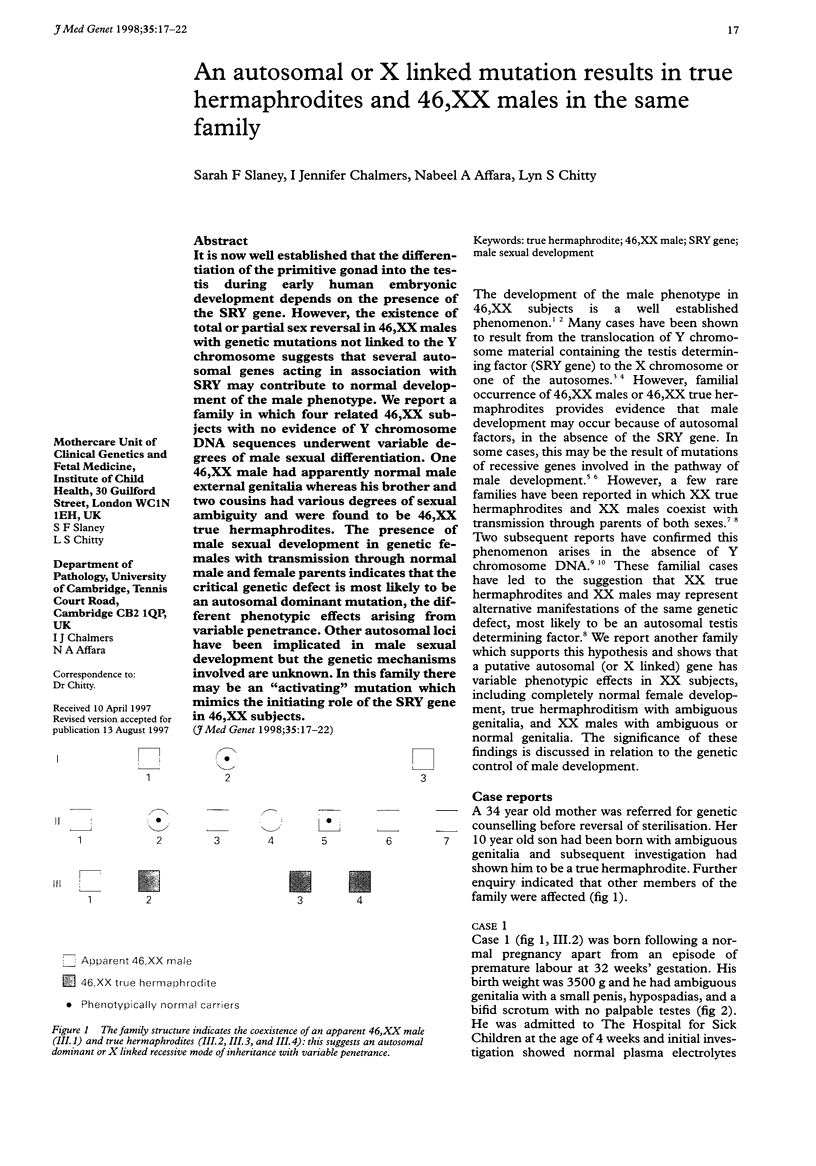
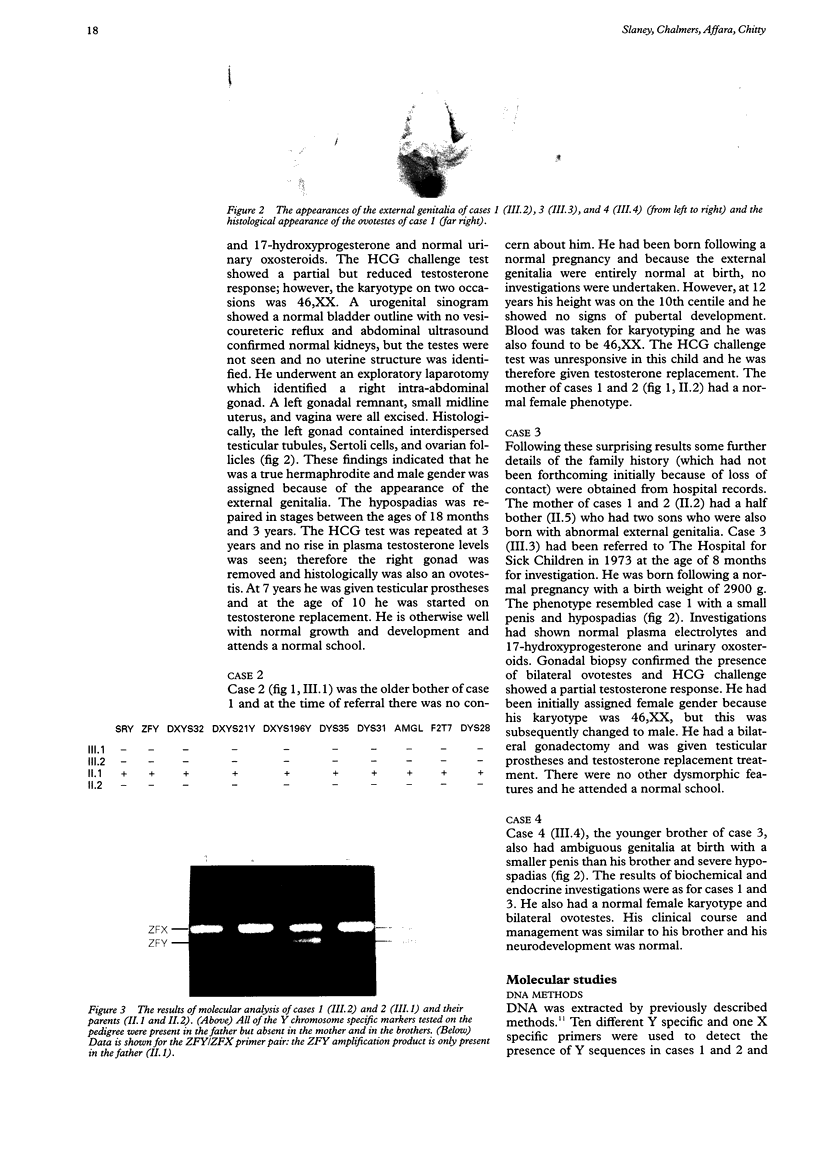
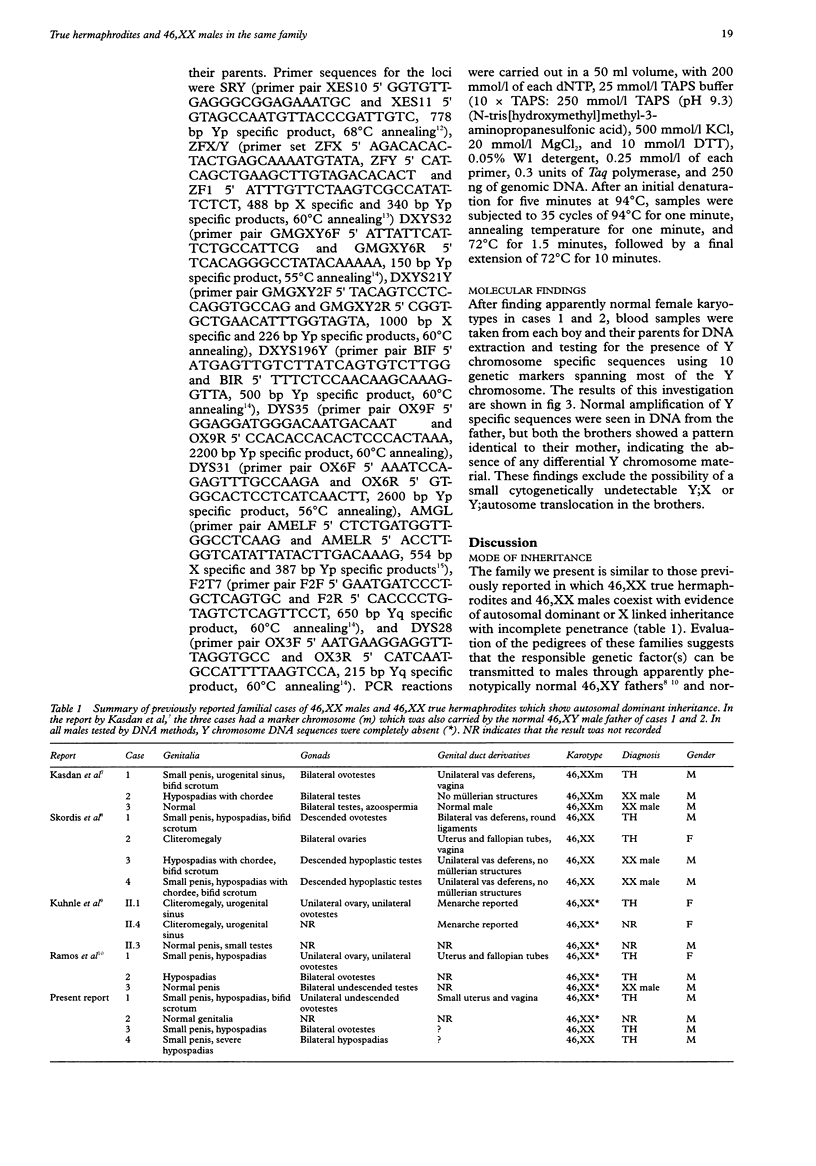
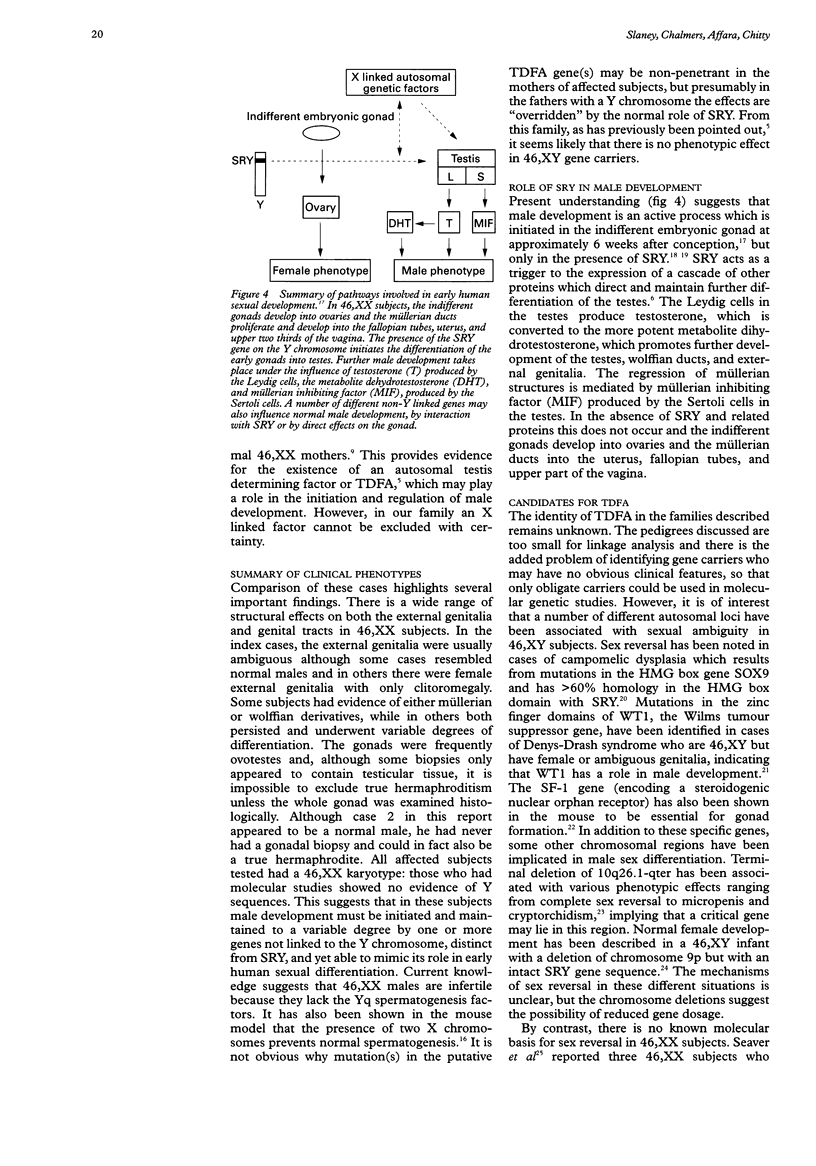

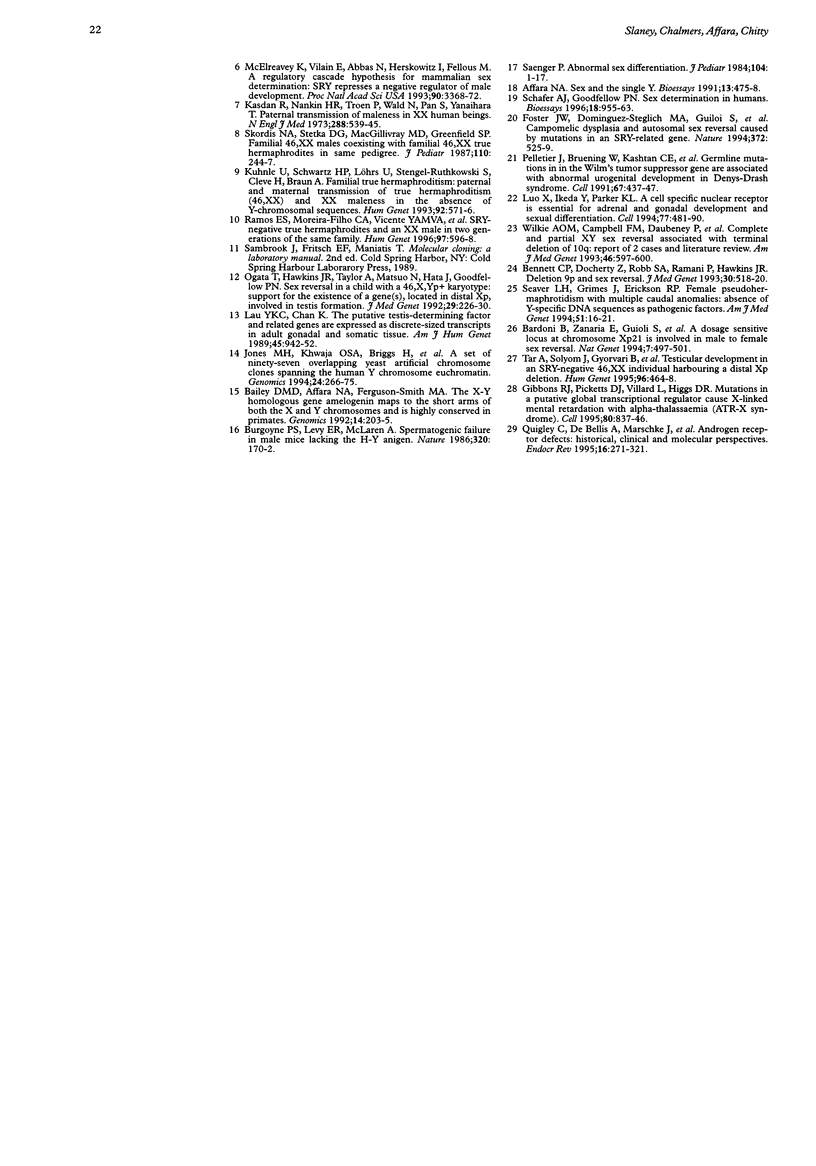
Images in this article
Selected References
These references are in PubMed. This may not be the complete list of references from this article.
- Affara N. A., Ferguson-Smith M. A., Tolmie J., Kwok K., Mitchell M., Jamieson D., Cooke A., Florentin L. Variable transfer of Y-specific sequences in XX males. Nucleic Acids Res. 1986 Jul 11;14(13):5375–5387. doi: 10.1093/nar/14.13.5375. [DOI] [PMC free article] [PubMed] [Google Scholar]
- Bailey D. M., Affara N. A., Ferguson-Smith M. A. The X-Y homologous gene amelogenin maps to the short arms of both the X and Y chromosomes and is highly conserved in primates. Genomics. 1992 Sep;14(1):203–205. doi: 10.1016/s0888-7543(05)80310-6. [DOI] [PubMed] [Google Scholar]
- Bardoni B., Zanaria E., Guioli S., Floridia G., Worley K. C., Tonini G., Ferrante E., Chiumello G., McCabe E. R., Fraccaro M. A dosage sensitive locus at chromosome Xp21 is involved in male to female sex reversal. Nat Genet. 1994 Aug;7(4):497–501. doi: 10.1038/ng0894-497. [DOI] [PubMed] [Google Scholar]
- Bennett C. P., Docherty Z., Robb S. A., Ramani P., Hawkins J. R., Grant D. Deletion 9p and sex reversal. J Med Genet. 1993 Jun;30(6):518–520. doi: 10.1136/jmg.30.6.518. [DOI] [PMC free article] [PubMed] [Google Scholar]
- Burgoyne P. S., Levy E. R., McLaren A. Spermatogenic failure in male mice lacking H-Y antigen. Nature. 1986 Mar 13;320(6058):170–172. doi: 10.1038/320170a0. [DOI] [PubMed] [Google Scholar]
- Ferguson-Smith M. A. X-Y chromosomal interchange in the aetiology of true hermaphroditism and of XX Klinefelter's syndrome. Lancet. 1966 Aug 27;2(7461):475–476. doi: 10.1016/s0140-6736(66)92778-4. [DOI] [PubMed] [Google Scholar]
- Foster J. W., Dominguez-Steglich M. A., Guioli S., Kwok C., Weller P. A., Stevanović M., Weissenbach J., Mansour S., Young I. D., Goodfellow P. N. Campomelic dysplasia and autosomal sex reversal caused by mutations in an SRY-related gene. Nature. 1994 Dec 8;372(6506):525–530. doi: 10.1038/372525a0. [DOI] [PubMed] [Google Scholar]
- Gibbons R. J., Picketts D. J., Villard L., Higgs D. R. Mutations in a putative global transcriptional regulator cause X-linked mental retardation with alpha-thalassemia (ATR-X syndrome). Cell. 1995 Mar 24;80(6):837–845. doi: 10.1016/0092-8674(95)90287-2. [DOI] [PubMed] [Google Scholar]
- Jones M. H., Khwaja O. S., Briggs H., Lambson B., Davey P. M., Chalmers J., Zhou C. Y., Walker E. M., Zhang Y., Todd C. A set of ninety-seven overlapping yeast artificial chromosome clones spanning the human Y chromosome euchromatin. Genomics. 1994 Nov 15;24(2):266–275. doi: 10.1006/geno.1994.1615. [DOI] [PubMed] [Google Scholar]
- Kasdan R., Nankin H. R., Troen P., Wald N., Pan S., Yanaihara T. Paternal transmission of maleness in XX human beings. N Engl J Med. 1973 Mar 15;288(11):539–545. doi: 10.1056/NEJM197303152881102. [DOI] [PubMed] [Google Scholar]
- Kuhnle U., Schwarz H. P., Löhrs U., Stengel-Ruthkowski S., Cleve H., Braun A. Familial true hermaphroditism: paternal and maternal transmission of true hermaphroditism (46,XX) and XX maleness in the absence of Y-chromosomal sequences. Hum Genet. 1993 Dec;92(6):571–576. doi: 10.1007/BF00420941. [DOI] [PubMed] [Google Scholar]
- Lau Y. F., Chan K. M. The putative testis-determining factor and related genes are expressed as discrete-sized transcripts in adult gonadal and somatic tissues. Am J Hum Genet. 1989 Dec;45(6):942–952. [PMC free article] [PubMed] [Google Scholar]
- Luo X., Ikeda Y., Parker K. L. A cell-specific nuclear receptor is essential for adrenal and gonadal development and sexual differentiation. Cell. 1994 May 20;77(4):481–490. doi: 10.1016/0092-8674(94)90211-9. [DOI] [PubMed] [Google Scholar]
- McElreavey K., Vilain E., Abbas N., Herskowitz I., Fellous M. A regulatory cascade hypothesis for mammalian sex determination: SRY represses a negative regulator of male development. Proc Natl Acad Sci U S A. 1993 Apr 15;90(8):3368–3372. doi: 10.1073/pnas.90.8.3368. [DOI] [PMC free article] [PubMed] [Google Scholar]
- Ogata T., Hawkins J. R., Taylor A., Matsuo N., Hata J., Goodfellow P. N. Sex reversal in a child with a 46,X,Yp+ karyotype: support for the existence of a gene(s), located in distal Xp, involved in testis formation. J Med Genet. 1992 Apr;29(4):226–230. doi: 10.1136/jmg.29.4.226. [DOI] [PMC free article] [PubMed] [Google Scholar]
- Pelletier J., Bruening W., Kashtan C. E., Mauer S. M., Manivel J. C., Striegel J. E., Houghton D. C., Junien C., Habib R., Fouser L. Germline mutations in the Wilms' tumor suppressor gene are associated with abnormal urogenital development in Denys-Drash syndrome. Cell. 1991 Oct 18;67(2):437–447. doi: 10.1016/0092-8674(91)90194-4. [DOI] [PubMed] [Google Scholar]
- Quigley C. A., De Bellis A., Marschke K. B., el-Awady M. K., Wilson E. M., French F. S. Androgen receptor defects: historical, clinical, and molecular perspectives. Endocr Rev. 1995 Jun;16(3):271–321. doi: 10.1210/edrv-16-3-271. [DOI] [PubMed] [Google Scholar]
- Ramos E. S., Moreira-Filho C. A., Vicente Y. A., Llorach-Velludo M. A., Tucci S., Jr, Duarte M. H., Araújo A. G., Martelli L. SRY-negative true hermaphrodites and an XX male in two generations of the same family. Hum Genet. 1996 May;97(5):596–598. doi: 10.1007/BF02281867. [DOI] [PubMed] [Google Scholar]
- Saenger P. Abnormal sex differentiation. J Pediatr. 1984 Jan;104(1):1–17. doi: 10.1016/s0022-3476(84)80581-8. [DOI] [PubMed] [Google Scholar]
- Schafer A. J., Goodfellow P. N. Sex determination in humans. Bioessays. 1996 Dec;18(12):955–963. doi: 10.1002/bies.950181205. [DOI] [PubMed] [Google Scholar]
- Seaver L. H., Grimes J., Erickson R. P. Female pseudohermaphroditism with multiple caudal anomalies: absence of Y-specific DNA sequences as pathogenetic factors. Am J Med Genet. 1994 May 15;51(1):16–21. doi: 10.1002/ajmg.1320510105. [DOI] [PubMed] [Google Scholar]
- Skordis N. A., Stetka D. G., MacGillivray M. H., Greenfield S. P. Familial 46,XX males coexisting with familial 46,XX true hermaphrodites in same pedigree. J Pediatr. 1987 Feb;110(2):244–248. doi: 10.1016/s0022-3476(87)80162-2. [DOI] [PubMed] [Google Scholar]
- Tar A., Sólyom J., Györvári B., Ion A., Telvi L., Barbaux S., Souleyreau N., Vilain E., Fellous M., McElreavey K. Testicular development in an SRY-negative 46,XX individual harboring a distal Xp deletion. Hum Genet. 1995 Oct;96(4):464–468. doi: 10.1007/BF00191807. [DOI] [PubMed] [Google Scholar]
- Vergnaud G., Page D. C., Simmler M. C., Brown L., Rouyer F., Noel B., Botstein D., de la Chapelle A., Weissenbach J. A deletion map of the human Y chromosome based on DNA hybridization. Am J Hum Genet. 1986 Feb;38(2):109–124. [PMC free article] [PubMed] [Google Scholar]
- Wilkie A. O., Campbell F. M., Daubeney P., Grant D. B., Daniels R. J., Mullarkey M., Affara N. A., Fitchett M., Huson S. M. Complete and partial XY sex reversal associated with terminal deletion of 10q: report of 2 cases and literature review. Am J Med Genet. 1993 Jun 15;46(5):597–600. doi: 10.1002/ajmg.1320460527. [DOI] [PubMed] [Google Scholar]
- de la Chapelle A. The Y-chromosomal and autosomal testis-determining genes. Development. 1987;101 (Suppl):33–38. [PubMed] [Google Scholar]
- de la Chapelle A. The etiology of maleness in XX men. Hum Genet. 1981;58(1):105–116. doi: 10.1007/BF00284157. [DOI] [PubMed] [Google Scholar]





